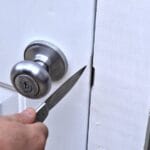Have you ever found yourself locked out, standing in front of a door that just won’t budge? It’s frustrating, and you might feel stuck with no quick solution.
But what if you could unlock that door using something as simple as a knife? You’ll discover easy, practical steps to open a locked door with a knife—without causing damage or calling for help. Keep reading, because knowing this trick could save you time and stress when you need it most.

Credit: www.wikihow.com
Tools You’ll Need
Opening a locked door with a knife requires the right tools. Not every knife works well for this task. Knowing which types of knives to use helps avoid damage. Some extra items can make the process easier and safer. Having all the tools ready saves time and frustration.
Types Of Knives Suitable
Choose a thin, flexible knife with a strong blade. Butter knives or plastic knives usually do not work. A pocket knife or a small kitchen knife is better. The blade should be smooth and not too sharp. A sharp blade might break or cause injury. Look for knives with a flat edge for better control.
Additional Helpful Items
A small screwdriver can help push the lock mechanism. A flat piece of plastic or a credit card can slide between the door and frame. Gloves protect your hands from cuts and scrapes. A flashlight helps you see inside the lock area. Keep these items nearby for a smoother process.

Credit: www.wikihow.com
Safety Precautions
Opening a locked door with a knife can be risky. Taking safety steps protects you and the door. Careful handling lowers the chance of injury or damage. Follow these safety tips before trying this method.
Protecting Yourself
Hold the knife firmly to avoid slips. Use a knife with a sturdy blade, not a flimsy one. Keep your fingers away from the blade’s edge. Wear gloves to protect your hands from cuts. Work slowly and do not use force. Stop immediately if the knife gets stuck.
Avoiding Door Damage
Choose a thin, flexible knife to reduce marks. Insert the knife gently between the door and frame. Avoid pushing hard to prevent bending or breaking the knife. Test small movements first to check the door’s response. Use a plastic card if possible for less harm. Remember, damaging the door can be costly to fix.
Techniques To Try
Opening a locked door with a knife takes patience and care. There are a few simple techniques you can try. Each method uses the knife in a different way to help move the lock or door latch. Practice gently to avoid damage.
Sliding The Knife Between Door And Frame
Choose a thin, strong knife with a sturdy blade. Insert the knife blade slowly between the door and the frame. Move the blade down toward the latch. Try to push the latch back inside the door. Use slow and steady pressure. Do not force the blade too hard. This method works best on spring bolt locks.
Using The Knife To Manipulate The Lock
Look closely at the lock mechanism. Insert the tip of the knife into the keyhole or latch area. Try to lift or push the lock parts inside. Use small, careful movements. The knife can act like a simple pick. This technique needs a bit of skill and patience. It works better on simple locks with exposed parts.
Wiggling And Prying Methods
Hold the knife firmly with one hand. Wiggle the blade gently while pushing against the latch or lock. Try to create space for the latch to move. You can also use the knife to pry the door slightly. Be careful not to damage the door or frame. This method works when the door is slightly ajar or has a loose latch.

Credit: www.youtube.com
When To Call A Professional
Trying to open a locked door with a knife can sometimes work. But not always. Knowing when to stop and call a professional saves time and avoids damage. Professionals have the right tools and skills to open doors safely. This part explains when calling a locksmith is the best choice.
Signs You Should Stop
If the knife bends or breaks, stop immediately. Forcing the knife can damage the lock or door. If the lock feels stuck or very tight, it may need special tools. Scratches or dents on the door show you might cause more harm. If you feel unsure or unsafe, do not continue. Taking too long without success means it’s time to call help.
Finding A Reliable Locksmith
Choose a locksmith with good reviews and clear prices. Look for someone licensed and insured. A reliable locksmith arrives quickly and works cleanly. Ask friends or neighbors for trusted recommendations. Avoid locksmiths who ask for large payments upfront. A good locksmith explains the process and answers questions clearly. This choice prevents scams and ensures the job is done right.
Preventing Future Lockouts
Getting locked out can be frustrating and stressful. Taking steps to prevent future lockouts saves time and worry. Simple measures help keep your home accessible without risking security. Here are practical tips to avoid being locked out again.
Spare Keys And Key Hiding Tips
Keep a spare key in a safe place outside your home. Choose spots that are not easy to find by strangers. Avoid obvious places like under the doormat or flower pots. Try hiding keys in less common spots, such as inside a fake rock or a secured box.
Give a spare key to a trusted neighbor or friend. This way, someone can help if you get locked out. Always check that the person is reliable before handing over a key. Update your hiding spots regularly to maintain security.
Upgrading Door Locks
Old locks can cause lockouts due to wear or damage. Consider upgrading to modern locks that are easier to use. Keyless locks with codes or fingerprint access reduce the chance of losing keys. Choose locks with good reviews and strong security features.
Regular maintenance of locks helps prevent jams and problems. Lubricate locks and check keys for wear often. Upgrading locks improves security and reduces lockout risks. It also adds convenience to your daily routine.
Frequently Asked Questions
Can A Knife Really Open A Locked Door?
A knife can sometimes open simple locks by sliding between the door and frame. It works only on basic locks.
What Type Of Knife Is Best For Opening Doors?
A thin, strong knife with a flat blade works best. Avoid thick or dull knives.
Is It Safe To Open A Door With A Knife?
Opening a door with a knife can damage the lock or door. Be careful to avoid injury.
Can I Use A Knife To Open All Door Locks?
No. Knives only work on simple latch locks, not deadbolts or advanced locks.
What Should I Do If A Knife Doesn’t Open The Door?
Try other tools or call a professional locksmith. Avoid forcing the knife to prevent damage.
Conclusion
Opening a locked door with a knife takes patience and care. Always try to stay calm and focused during the process. Using the right knife and gentle pressure helps avoid damage. Practice on old doors to improve your skill safely.
Remember, this method works only on simple locks. For stronger locks, seek professional help instead. Safety matters most, so never force the knife too hard. Keep these tips in mind to handle locked doors carefully and confidently.





